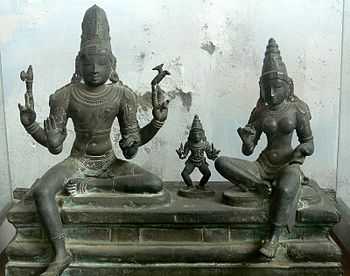Somaskanda
Somaskanda is a particular form of representation of Shiva with his consort Uma, and Skanda as a child. This family group depiction of Shiva originated during the 6th-8th centuries during the period of the Pallava in South India. The representation shows Shiva with four arms and Uma, and between them the infant Skanda is shown as dancing with ecstasy. Over a period of time, a number of such depictions have been discovered from different regions which were once under the control of Pallavas.
[[]]
References
- Dictionary of Hindu Lore and Legend (ISBN 0-500-51088-1) by Anna Dallapiccola
Somaskanda is a particular form of representation of Shiva, with his consort Uma towards its left and child Scanda seated in between.
The Somaskanda manifestation of Lord shiva is a unique concept of Tamil region. It represents Shiva as supreme godhead as a father by the side of his family,
his wife Parvati as a graceful mother and full of tenderness and their son Skanda or Murugan dancing with ecstasy. Here Shiva comes with four arms.
This family-group depiction of Shiva originated during the sixth to eighth century during the period of the Pallava in South India. Most of the temples around Kanchipuram in TamilNadu bear Somaskanda panel behind the Shiva Lingam in the sanctum. The Tyagaraja temple represents a special class of iconic representation of Somaskanda. Over a period of time a number of sculptures bearing Somaskanda have been discovered from different regions, which were once under Pallava rule.
